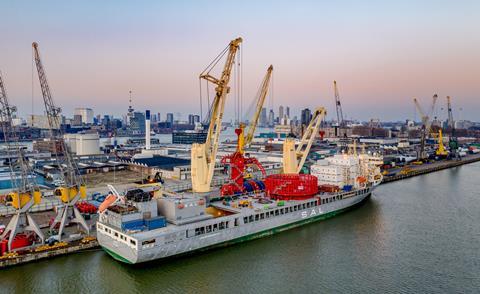HLPFI’s David Kershaw speaks with Richard Seeg and Svend Andersen regarding the recent deal that will see Intermarine and SAL Heavy Lift come together to service the Americas and cross-Atlantic trade.

SAL Heavy Lift and Intermarine are coming together to service the Americas and cross-Atlantic trade. Earlier this week, HLPFI reported that SAL Heavy Lift acquired a majority stake in Intermarine. Industry veteran Svend Andersen has joined Intermarine as its ceo. He will work alongside president Richard Seeg and Chad Call, the carrier’s vice president and chief financial officer.
Andersen said: “The joining of Intermarine with the SAL organisation is a perfect matching of two companies which share the same basic set of values and business philosophy yet with a different fleet of vessels, resources and outreach. In combination, it makes an unmatched setup in cross-Atlantic trading and intra-Americas heavy lift shipping.
“I have invested in this venture, as I see great prospects in bringing the Intermarine brand and business onwards under the helm and support of SAL Heavy Lift as a top brand in the heavy lift shipping industry.”
He added that when he stepped down from his role as ceo at BBC Chartering last year, he wanted to stop and take it easy. Ultimately, something was missing. “I must say that I wanted to stay in contact with the business and the segment – something that I had been doing for close to 50 years.” The opportunity that arose with Intermarine was too good to turn down.
“It is a great opportunity. I had been [with Intermarine] for a couple of years back in the 1990s and I know many of the people here. I feel that this could be nice and there is a challenge in it – so why not? I am very happy to back onboard in this setup at Intermarine, together with the team in Hamburg at SAL Heavy Lift… I know for sure that we can work together and make good things happen.”
Commenting on the merger, Seeg said: “I think SAL has seen the value in what it is that we are doing [as Intermarine], and we certainly see the value in SAL and its organisation.” Intermarine is set to benefit from SAL’s connections in the European market, and that the cross-Atlantic trade is a target for the group. “SAL also operates different vessels in a different segment. They have different customers, or access to different parts of the same customer. This will create some synergies, and vice versa,” he said.
Andersen, meanwhile, highlighted South America as another region where both carriers would benefit from their respective strengths. “SAL has good operations from the Far East down to South America, where Intermarine is very well positioned today.”
Future growth
“I think the buzzword of the past 12 months or so has been uncertainty – around the pandemic, around oil prices, around elections,” Seeg added. “But, challenges also create opportunities. While we continue to focus on our main trade lanes and our main business, I have no doubt that other opportunities will present themselves. Within the new organisation, with the team we have in place, we are better prepared to take advantage of those opportunities as they come up than we have been, certainly in the recent past.”
For the time being, there will be no changes to the respective carrier’s agency networks or fleet structure. “The perfect ship for the market or the perfect ship for a given trade lane that changes over time, as the business, market and customer requirements change,” Seeg explained. “One of the things that Intermarine has been good at is looking forwards to the future and trying to make sure we have fleet that matched together with what our customers’ needs are.”
















